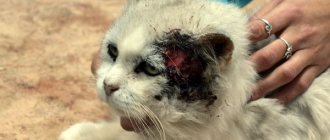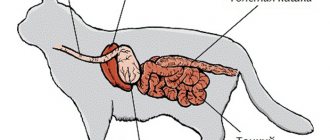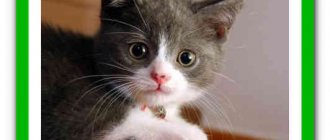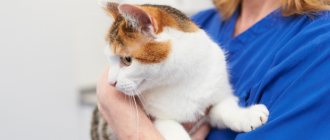What you need to know about feline stroke
- Stroke in cats (ischemia) is a condition in which blood circulation in the brain is disrupted and neurons responsible for performing important functions in the nervous system begin to die.
- There are two forms of this disease: hemorrhagic (when a vessel bursts and hemorrhage forms),
- ischemic (when a vessel becomes blocked and an obstacle to normal blood circulation in the brain appears).
In the latter form, internal damage to the functionality of organs can be so severe that the animal can die almost immediately.
- The severity of the consequences of a stroke depends not only on the area of brain damage, but also on the affected area. The more serious and important the affected areas of the brain, the worse the animal will feel and the more severe the consequences.
- Neutered cats are more likely to have strokes due to decreased physical activity and excess weight due to an unbalanced diet, as for castrated cats.
Symptoms and treatment of microstroke
A microstroke is a brief circulatory disorder affecting a small area of the brain. With a micro-stroke, the symptoms are practically no different from a stroke, but the animal recovers much faster. Within a day, the cat comes to its senses, is interested in food, and the signs of paralysis are smoothed out.
Typically, the clinical picture of a microstroke develops in cats as follows:
- Sharp headache. The cat may stand against the wall and rest its forehead against it or try to hide in a dark place. Does not respond to calling or stroking. Slowly, barely moving his paws, he wanders around the apartment.
- The cat becomes lethargic and sleepy. May fall over as it loses orientation in space.
- The pet does not recognize the owners - it is afraid of them, or, on the contrary, shows sudden aggression. This is due to memory loss.
- Brief seizures may occur. Often - on the affected side of the body.
- The cat constantly vomits, even when the cat's stomach is already empty.
Cat has a headache
Treatment of a microstroke is aimed at relieving the symptoms of the consequences and restoring cerebral circulation. The doctor prescribes antiemetics, nutritional solutions, and painkillers.
Important! For severe convulsions, anesthesia is indicated.
Provoking factors
The causes of different types of ischemia vary somewhat. Also, one can cause the other.
The main causes of hemorrhagic stroke:
mechanical damage to the skull (concussions, bruises);- inflammation of blood vessels;
- brain tumors;
- abnormal deviations in the structure of blood vessels;
- entry of toxic substances and poisons into the bloodstream;
- blood pressure surges;
- severe infections accompanied by a sharp and prolonged increase in body temperature;
- food poisoning with prolonged and severe vomiting;
- sudden stressful situations;
- excess weight, which increases the fragility of blood vessels;
- ischemia.
The main causes of ischemic stroke:
- diseases of the cardiovascular system;
- problems in the functioning of the excretory system (in particular the kidneys);
- the presence of internal parasites and their migration through the bloodstream;
- thyroid dysfunction;
- blockage of blood vessels by a thrombus;
- diabetes;
- Cushing's syndrome (hormonal disorders);
- improper hormonal therapy (most often due to self-medication).
If doctors are unable to determine the exact cause that provoked ischemia, then the case is called causeless or idiopathic. This condition will definitely happen again, because... the cause cannot be eliminated. After a second stroke, cats often die.
Diagnostics
If you suspect that your pet is developing a stroke, you must immediately take the animal to a veterinary clinic.
Attention! It is prohibited to provide any first aid on your own. Firstly, without examination it is impossible to determine that an animal is developing ischemic encephalopathy. Secondly, the principles of veterinary medicine differ significantly from human medicine, so there is a risk of aggravating the pet’s condition.
It is imperative to prepare a complete medical history of the cat and submit it to the veterinarian. Such information will not only help diagnose a stroke, but also speed up the appointment of the correct treatment. If problems with blood circulation appear as a result of injury, the veterinarian will additionally examine other internal organs and do everything possible to stabilize the animal’s condition.
As soon as first aid is provided, the specialist will prescribe:
- complete blood test of the pet (including biochemical profile);
- urine test (to identify possible kidney or liver problems);
- thyroid hormone test (to determine whether a stroke has developed as a result of hormonal imbalances).
In the most modern veterinary clinics, a CT or MRI is required to assess the extent of damage to brain tissue and exclude (or confirm) the presence of blood clots in the blood vessels.
How a stroke manifests itself - what to pay attention to
After a cerebrovascular accident, the pet exhibits unusual behavior that cannot go unnoticed by an attentive owner. Stroke in cats has the following main symptoms:
- Bowed head at a “strange” angle – most often on one side. It is explained by the rapidly developing weakness of the neck muscles, which can persist for a long time after the onset of the pathology (up to several weeks).
- Impaired movement coordination. An agile and agile pet suddenly becomes clumsy, acquires a shaky gait, does not maintain balance, constantly falls on its side, and moves unnaturally in a circle.
- Ataxia is the inability of a cat to perform its usual routine movements due to muscle weakness throughout the body (for example, it cannot raise its paw to wash its face).
- Changes in behavior, disorientation, inexplicable fear. After a stroke, the cat becomes literally illogical and unusual. Confusion is noted, the pet may avoid its owners or even rush at them, hiding somewhere from fear. Veterinarians explain this fact by probable memory loss, when the animal does not remember the people around him, the environment, or his basic cat skills.
- Temporary blindness may develop - after a stroke, a cat will obviously bump into objects, fall from objects (furniture, thresholds), and not immediately find bowls of food. Thanks to the development of other senses, the loss of vision is usually somewhat compensated for, so it is not immediately noticed by the owner.
- Sudden lethargy. An energetic pet under normal conditions suddenly suddenly becomes lethargic and lacking initiative. She doesn't even pay attention to attempts to flirt with her.
- Decreased or complete loss of appetite. This is because the facial and throat muscles weaken, making it difficult to chew and swallow. There are risks of choking and suffocation. Loss of consciousness is also likely when bending your head towards a bowl of food.
- Asymmetric change in pupil size (anisokyria).
- Involuntary urination and/or bowel movements. Occurs when the abdominal muscles are involved in the pathological process. The animal not only does not control these processes, but also does not understand what is happening.
- Sharp tics of the eyeballs to the side back and forth (nystagmus).
- Sudden loss of consciousness, lasting from a few seconds to 5 minutes.
- After a stroke, a cat may experience limb spasms and/or paralysis. Usually one half of the body is affected.
- Signs of respiratory distress, vomiting, epileptic convulsions.
Not all owners of mustachioed pets know the signs of stroke in cats. But recovery depends on how quickly first aid is provided by a specialist.
Stroke treatment
Treatment of hemorrhage in cats has an important goal - reducing inflammation. Thanks to this, it is possible to reduce negative effects after damage to the blood vessels of the brain. In veterinary medicine it is usually prescribed:
- Rehydron solution for cleansing the body.
- Blood thinners.
- Anti-inflammatory drugs are necessary to reduce inflammation in the brain.
- Calming agents.
- Tranquilizers.
- Antispasmodics.
- Vitamins.
- The cat's nutritional diet does not change, however, it is important not to give the pet food rich in fat.
The sooner first aid is provided and the cat goes for treatment, the greater the chance of a successful outcome.
If cats do not improve within 72 hours, then most likely you should not count on a favorable outcome.
Rehabilitation period
There is no point in treating a cat at home; it needs to be left in the clinic for a while. The treatment period usually reaches 2 months.
- The animal should lie on a clean and warm bedding.
- The cat needs to be constantly massaged to avoid bedsores.
- Drafts must be avoided to prevent the animal from developing pneumonia.
- Physiotherapy is prescribed.
Pneumonia is the most common cause of death in cats after cerebral hemorrhage.
Consequences of a stroke
Consequences in cats vary from the size of the hemorrhage and the time spent before providing qualified assistance. They may continue to have the following symptoms:
- Visual impairment. Cats cope well with this problem in life, as they perfectly navigate in space with the help of innate reflexes.
- Partial paralysis of the limbs can accompany the pet for the rest of its life. He may have trouble walking. It would be nice to protect it from falls from heights in the future.
- Hearing impairment.
- Memory impairment.
First aid
If the owner notices more than two of the listed symptoms, it is necessary to take the pet to the veterinarian as soon as possible! Before the doctor arrives or before you take your pet to the clinic on your own, you need to:
- gently place it on its side on any not very hard horizontal surface;
- talk to the animal, try to calm it down verbally, stroke it;
- make sure that the mouth is not clogged with vomit or viscous saliva;
- check that the tongue is not stuck and that it is not blocking the airway.
It is strictly forbidden to give your cat any medications on your own, because... There are diseases that have similar symptoms to stroke, but for them anti-stroke therapy is contraindicated!
After all these procedures, take the cat to a specialist as soon as possible, because... the severity of the consequences directly depends on the speed of the necessary medical care. Home treatment for stroke in cats consists of strictly following the veterinarian's instructions!
Treatment of the disease
At home, treating a cat's stroke can only be done under the supervision of a veterinarian. Self-medication is unacceptable. Treatment of the disease is complex. There is no specific therapy for the disease. To improve your cat's condition, you need the following :
- eliminating the causes of stroke;
- elimination of inflammation in the brain - it occurs during a stroke in the brain due to foci of tissue necrosis or hemorrhage, the hematoma from which in the process of resorption provokes inflammation;
- reduction of brain damage;
- improvement of vascular condition.
It is important to begin treatment for stroke in cats as soon as possible. Therapy that is started within the first 60 minutes after a stroke significantly increases the likelihood of a cat’s recovery. The animal body, unlike humans, is able to recover very effectively. Treatment that is given on time helps to avoid complications such as paralysis, which could otherwise be permanent.
© shutterstock
Whenever possible, the cause of the stroke is determined so that the prescribed treatment is as targeted as possible. If the cause of the stroke cannot be determined, the cat undergoes comprehensive comprehensive treatment. This therapy includes :
- anti-inflammatory drugs that act in the brain - if not administered, complications of the disease, such as meningitis, may occur, which significantly reduces the cat's chances of survival. Treatment lasts up to a week;
- antiemetic drugs - not required for all cats and are used if vomiting is observed at the time of the stroke. They fight the consequences of a stroke, such as dehydration and damage to blood vessels in the throat from tension;
- sedative medications are necessary to eliminate the animal’s disorientation and panic attacks, which complicate the process of treating a stroke and only aggravate the animal’s condition. The drug must be prescribed by a veterinarian, as well as the dosage. The owner should not voluntarily change the scheme of giving the medicine, as this will only worsen the animal’s condition;
- antibiotics – their use is necessary to prevent the appearance of bacterial lesions in the animal’s body, since during a stroke the cat’s immunity is seriously reduced, and therefore it cannot fully protect itself from constant attacks by pathogens;
- neuroprotectors – the most common of them in veterinary practice are Cerebrolysin and Cerebrolysate. Melgama and Mexidol can also be prescribed. The action of these drugs is aimed at improving brain function and reducing brain damage during a stroke. They also strengthen blood vessels and speed up the cat’s recovery process after a stroke. Treatment can last up to several months;
- decongestants – necessary to prevent cerebral edema, which can be fatal if very severe; since the skull cannot stretch, the organ will be compressed and completely injured;
- antispasmodics - help relieve pain, which during a stroke usually occurs in the head and neck area and can be very severe.
© shutterstock
It is also very important to prevent dehydration in cats with stroke, which can develop due to disruption of the organ systems and is especially pronounced in the first days after the stroke. To do this, infusions of Ringer-Locke solution are given every 3 hours. In order not to injure the veins, a subcutaneous drip is usually used, which is no less effective.
In some cases, a veterinarian may prescribe feeding a cat with a stroke water and honey. Typically, a teaspoon of product is needed for 1 glass of water. During the day, you need to give the animal the entire portion of the solution. During the period of such treatment, the cat’s condition is constantly monitored so that the sweetness does not cause too much increase in blood sugar levels, which is dangerous for the cat. Such a consequence of treatment is unacceptable.
Absolutely forbidden!
At home, if ischemia is suspected, the following independent actions are prohibited:
- Do not apply cold compresses to the scalp area! This will only contribute to the spread of the hematoma formed in the brain.
- Do not give any injections without permission or verbal instructions from your veterinarian!
- It is forbidden to give any tablets, especially when the animal is unconscious!
The best thing an owner can do is to take the pet to a veterinary facility as soon as possible!
First aid for stroke
First aid can play a critical role in recovery. If a stroke is suspected, owners can do the following:
- place the cat so that its head is approximately 40-45 degrees higher than the rest of the body;
- provide the animal with access to fresh air, remove the collar, if any;
- if vomiting occurs, lay the cat’s head to one side and slightly down;
- Contact a veterinary clinic immediately.
Pulmonary edema in cats: causes, symptoms, treatment
Important! If vomiting or convulsions occur, under no circumstances should you try to open the cat's jaw with your fingers or any other objects. There is a high risk of damaging the cat’s oral cavity, knocking out its teeth, and getting severe bites.
Treatment
There is no specific treatment for stroke. Symptomatic therapy is usually carried out, depending on what became the provoking factor. It is very important to establish the cause of the pathology in order to prevent recurrence of the condition and effectively carry out treatment and rehabilitation measures. The full treatment period can take up to 2 months, rehabilitation – up to six months.
Main direction of therapy:
- Maintaining heart function.
- Normalization of respiratory function, if necessary.
- Restoration of blood circulation.
- Administration of painkillers and anti-inflammatory drugs.
- Strengthening vascular walls.
- Administration of blood thinners.
- Restoring the functioning of the nervous system by improving the nutrition and metabolism of neurons.
- Relieving spasms.
- General strengthening and toning of the whole body. It is important to take B vitamins, which are important for the nervous system.
- Diuretics (to prevent cerebral edema).
- In some cases, tranquilizers are prescribed (very rarely).
An approximate drug treatment regimen based on symptoms may look like this (do not use without consulting a veterinarian!):
- Cordiamine (important to use in the first 3 days) – subcutaneously or into the muscle at 0.1-0.12 ml/kg. Sulfocamphocaine - 0.3-0.5 ml twice a day intramuscularly.
- Eufillin – 0.1-0.2 ml/kg body weight subcutaneously.
- No-Shpa (drotaverine) – 1/3 tablet once at night.
- Gamavit - 2 ml subcutaneously 1-2 times a day. Catozal - intramuscularly, subcutaneously or into a vein, 0.5-2.5 ml, depending on the size of the individual and its condition.
- Thiotriazolin - ¼ tablet or 0.5 ml of solution into the muscle of cats up to 3 kg, or ½ tablet or 1 ml of solution intramuscularly if heavier than 3 kg. Twice a day.
- Neuromidin 1.5% – 0.2 ml intramuscularly for individuals weighing up to 5 kg once a day. Cerebrolysin – 0.5-1 ml per animal once a day in the thigh. Mexidol-Vet – 10-15 mg/kg 1-3 times a day, depending on the severity of the condition.
- Piracetam - 0.5-1 ml intramuscularly once a day.
- Furosemide – 0.5-1 mg/kg subcutaneously or intramuscularly. Torsemide – 0.05-0.1 mg/kg once a day. It is better to use furosemide, because cats are often not sensitive to torasemide.
- Glucose 5% - intravenously, 15-20 ml once a day, depending on the weight of the animal.
- Dexamethasone (in severe condition) - 8-day regimen: 2 days intramuscularly at 0.4 ml, 2 days - 0.3 ml, 2 days - 0.2 ml and 2 days - 0.1 ml once a day.
- Pentoxifylline (strictly in a hospital under the supervision of a veterinarian) – 4.5-5 mg/kg orally in the form of tablets up to 3 times a day or intramuscularly 0.1-0.3 ml per animal.
- Cerucal (metoclopramide) – 0.3-0.7 mg/10 kg of weight up to 3 times a day for vomiting.
The duration of therapy is determined by the veterinarian individually in each case, taking into account numerous factors.
If timely assistance is provided, improvements should be noted in the first three days. If after 72 hours of active therapy no changes in health status were noted, the prognosis is unfavorable.
First aid
If the fellinologist notices one or more of the pathological symptoms of a stroke described above, his task is to deliver the cat to the clinic without causing harm during transportation. To do this, the cat owner must comply with the following requirements:
- Place the animal on a leveled solid surface
- Turn your head to the side and hold it carefully so that the cat does not choke on vomit.
- When regurgitation contractions occur, the mouth is cleared of expelled conglomerate.
- During delivery, the cat is petted, calmed, and praised.
- You cannot give pills, give injections, or apply cold to the head.
Rehabilitation period after a stroke
For the first 3-5 days, it is better to leave the animal in the hospital so that the entire treatment process is under the supervision of a specialist. It is important to note the slightest changes in the condition, both in the direction of improvement and deterioration, in order to promptly correct therapy.
- The cat should lie on dry, soft, warm bedding, which should be changed regularly as it becomes contaminated with urine and feces if it has uncontrollable bowel movements.
- If the animal cannot roll over on its own, it must be done independently at regular intervals to avoid bedsores.
- If paralysis is noted, then regular massage of the body and, especially the paralyzed limbs and abdomen, is necessary to improve intestinal motility.
- It is strictly forbidden for an animal to be in a draft or in a cold room - the risk of developing pneumonia increases. This is the most severe complication after a stroke, from which paralyzed cats often die due to the fact that the body does not have enough strength to fight the infection.
- With the right therapeutic approach, within the first 3 days you can tell whether the animal will recover or not. The consequences of ischemia are usually not as pronounced as in humans. Murok has well-developed compensatory and adaptive properties and many minor deviations in behavior after a stroke may not even be noticed by the owners.
- There should always be access to clean water and easily digestible liquid food. You may have to carefully spoon feed and drink from a syringe. If it is impossible to feed yourself, rehydration and nutritional drips are placed.
- It is possible that blood thinners will have to be used for life (if the animal is prone to blood clots).
- Physiotherapy is acceptable according to indications - electrophoresis, magnetic therapy, electrical stimulation.
Prevention
Of no small importance in preventing stroke is the accurate determination of the causes of the disease. If you ignore additional tests prescribed by your doctor, a stroke can occur again and kill your pet.
Many of the diseases that our pets suffer from are exactly the same as in humans. Animals have allergies, ear infections, pneumonia and even heart disease. For example, the symptoms of a stroke in a cat are extremely similar to those of a human stroke. A cat usually does not suffer from cholesterol plaques like a person, but in old age the pet may well be overtaken by a stroke.
Fortunately, this is not a very common disease in animals, but just like in humans, when a cat has a stroke, less than the required amount of blood suddenly begins to flow into the brain, which leads to oxygen starvation, death of brain cells, and disruption of its functioning.
Today this disease is divided into two types.
1. Hemorrhagic stroke in cats is characterized by the rupture of a blood vessel, resulting in hemorrhage. It occurs when there is a decrease or complete cessation of blood flow to the brain when a vessel ruptures. Then the blood simply does not reach the brain, but accumulates between the skull and the brain.
The causes of this type of stroke may be:
- stressful conditions;
- improper diet, in which the cat consumes fatty foods;
- a tumor in the brain, it can cause hemorrhage;
- pathological (abnormal) structure of the walls of feline blood vessels;
- food poisoning, toxins or poisons;
- infections that cause fever due to complications;
- inflammation of arterial walls;
- excessively high blood pressure;
- ischemic stroke.
Very often in cats it is impossible to find out the true cause of this dangerous disease. If it is impossible to conduct a thorough examination of a domestic cat using special equipment (computed tomography, magnetic resonance imaging, ultrasound, and others), then veterinarians usually call the stroke idiopathic, that is, occurring for no reason. However, competent veterinarians understand that there is no disease without a cause.
When treating a stroke, it is necessary, first of all, to find out the cause and, if possible, eliminate it, otherwise the strokes will recur, and it is not known whether the pet will remain alive after suffering a second or third case of the disease.
Preventing stroke in cats
To prevent the occurrence of circulatory disorders in the brain, it is enough to follow simple recommendations:
- A cat should always have access to fresh air, even if the animal lives in an apartment, is considered completely domestic and does not go outside. Regular “walks” on the balcony are enough.
- Monitor the fat content in your diet.
- Try not to overfeed castrated cats.
- Be sure to carry out anthelmintic measures in a timely manner.
- Try to avoid stressful situations for the animal.
- Play with your pet regularly to keep it active.
- Monitor blood pressure in aging cats.
- Store household chemicals and poisons in places where they cannot be accidentally found and swallowed by your pet.
Risk factors
Epilepsy in cats: symptoms, treatment, how to stop seizures
A stroke always happens suddenly, but this acute condition can be prevented if you carefully monitor your cat and undergo routine medical examinations from time to time.
Obesity in a cat
There may be several prerequisites for the occurrence of a cerebral stroke:
- autoimmune diseases;
- chronic hypertension;
- obesity;
- diabetes;
- acute and chronic intoxication of the body;
- chronic stress.
Question answer
Do cats even have strokes?
Yes, sometimes. But due to the fact that owners of mustachioed pets do not know its first symptoms and do not seek help from a veterinarian, the animal often dies. And the owners are at a loss as to why the animal died or why it began to behave strangely.
What if a cat doesn't move after a stroke?
If breathing continues, the animal most likely has lost consciousness. It is necessary to immediately take the animal to the clinic to revive it and provide first aid. If there are no signs of respiratory activity, the animal is likely dead. Lack of motor activity while maintaining consciousness may indicate paralysis - unilateral or bilateral.
A cat has a stroke after anesthesia - is this possible?
Yes, it is possible - as a side effect of anesthesia drugs. Most often, the pathology develops according to the ischemic type, i.e. against the background of increased blood viscosity, a blood clot forms, which clogs the vessel and disrupts blood flow. It can occur not only in the postoperative period at the time of recovery from anesthesia, but also at the time of the operation.
Are there special drugs for stroke?
No, there are no specific special medications that could be used to cure a stroke. There is a selection of therapeutic agents that restore the cat's condition to normal, as far as possible in each specific case.
A cat has a stroke - first aid
If signs of ischemia are noticed in Murka, it is necessary to provide her with complete rest, lay her on her side on any horizontal surface and check her mouth for the presence of thick saliva or vomit, so that there are no obstructions to breathing. After this, you need to call the veterinarian home and voice the assumption that the cat most likely has a stroke, or take the pet to the veterinary clinic yourself. During transportation, you need to stroke your pet and soothe it with your voice. It is forbidden to give any medications yourself or do any injections!
How to treat a stroke in a cat?
Self-treatment of pathology is strictly prohibited! In veterinary care, it is advisable to begin therapy only after the cause has been determined. The necessary medications are usually prescribed:
- cardiac;
- restoring blood circulation;
- painkillers and anti-inflammatory;
- vascular strengthening;
- blood thinners;
- antispasmodic;
- nootropics;
- restoratives and vitamins;
- diuretics.
How to treat an animal
A stroke is such a serious pathology that it cannot be treated at home. The pet is hospitalized even if an illness is suspected, in order to have time to provide him with emergency care.
The main focus of therapy is to reduce the inflammatory process and try to avoid irreversible consequences, so the animal is immediately placed under a mask to saturate the brain with oxygen.
After this, the remaining measures are taken:
a saline drip for dehydration;- infusion procedures aimed at thinning the blood and dissolving blood clots;
- anti-inflammatory, antiemetic agents that relieve unpleasant symptoms;
- antibiotics to prevent the development of infection.
Symptoms of a stroke have a depressing effect on the animal’s psyche: due to damage to the lobes of the brain, disorientation is observed. Therefore, sedative medications are also introduced into the course.
Types of drugs for stroke
| Group name | Description | Suspected medications |
| Analeptics | They have a positive effect on the nervous system. Activate the heart and brain | Intramuscular Cordiamine |
| Antispasmodics | Relaxes the walls of blood vessels, which helps relieve pain | In tablets, crushed into powder (Spazmalgon, No-shpa) |
| Bronchodilators | Necessary for restoring respiratory function | Subcutaneously Eufillin |
| Diuretics | Prescribed for high blood pressure to remove excess fluid from the body | Intramuscular Furosemide |
| Immunostimulants | Increases the protective properties of tissues, which accelerates the recovery of the body | Intramuscular Gamavit |
| Cholinesterase inhibitors | Promote the passage of impulses sent by the brain to other parts of the body | Intramuscular Neuromidin |
| Nootropics | Promotes blood circulation to the brain | Intramuscular Piracetam, Cerebrolysin |
| Antioxidants | Improve blood circulation, have an anti-ischemic effect, accelerate recovery | Intramuscular Mexidol, Thiotriazolin |
The first days of treatment are carried out under the supervision of a doctor .
The cat is given sterile bedding, which should be changed periodically (a paralyzed animal will walk under itself). To prevent bedsores from forming in the tissues, the cat is turned from side to side from time to time.
Home treatment
It should be remembered that shifting alone will not improve blood circulation. Therefore, it is important to give your cat a massage every day (this will be taught at the veterinary clinic). Blood flow determines how quickly the recovery of brain function begins.
Timely detected pathology can be treated. Therapy is prescribed for at least 2 weeks. Therefore, you need to continue it at home.
The cat owner will have to take on the mission of a medical worker or hire a specialist who will come and give the animal injections.
Video
Symptoms of a stroke in a cat usually appear suddenly. The animal suddenly loses its balance and looks absolutely helpless. This disease is a serious disorder of the blood supply to the brain, which primarily affects the cranial nerves. Veterinarians determine whether a stroke is occurring through a thorough examination of the cat's auditory organs.
To diagnose a stroke, cats undergo the same procedures as humans. For example, mandatory procedures include tomography and abdominal x-rays.
The following changes in the animal's behavior indicate a stroke:
A sharp loss of balance, as well as obvious signs of disruption of the vestibular apparatus; - drowsiness, apathy, loss of interest in the environment; - rapid breathing or asthma attacks; - tilting of the head, reminiscent of spasms; - the cat’s pupils may sharply constrict, the eyes will droop and the eyelids will tremble (if the animal has one pupil dilated and the other narrowed, then this should also be regarded as the first symptom of a stroke); - paralysis of the nose, mouth and impaired reflexes (usually only one side of the body is paralyzed); - temporary loss of consciousness or coma; - loss of appetite or physical inability to perform swallowing and chewing reflexes; — partial or complete loss of vision is possible, the cat may bump into interior objects as if they were not in its path; - In rare cases, animals experience frequent urination that they cannot control.
The first symptom of a stroke may be a cat walking in a circle with its head hanging low forward. The animal may make sounds that resemble a groan.
Behavioral disorders in older cats
There are no specific complications after a stroke; without treatment, the cat dies. But there may be “undertreated” damage or signs of improper care. The first case includes several phenomena similar to the initial symptoms:
- poor vision (or one eye cannot see, sometimes both);
- impaired motor function (lameness may remain, the cat may walk sideways);
- memory losses.
Owners may stop treatment (for example, if the animal seems to feel better), and some disorders will remain untreated and unnoticed. A cat can live a long life with these changes, if they allow it, of course. And the more persistent and attentive owners see the job through to the end, and their cats recover completely.
The following causes of dilated cat pupils are classified as physiological:
- Estrus: the cat is excited, and in this state the adrenal glands release adrenaline into the blood, which causes the pupils to dilate. When the sexual hunt ends, the pupils return to normal.
- Game: when making jumps and performing complex turns, the pet is excited, it needs to strengthen its visual perception.
- The cat is dissatisfied with something: it hisses, arches its back, and bulges its eyes. This condition passes very quickly.
- Hunting: To track down prey, good vision is necessary, which is achieved by increasing the lumen of the visual lens.
- Night or low light - to see better, you need to open your pupils wide.
- Stressful state when a new pet appears in the house, or fear, the sound of a vacuum cleaner, or an encounter with an aggressive dog. When the animal calms down, the pupil narrows.
- Rehabilitation after surgery. The residual effect of anesthesia on the eyes persists for a long time.
- Old age: visual acuity also decreases in humans, but cats do not wear glasses, but solve the problem by expanding the lumen of the lenses.
Be sure to read: The most dangerous cats, list of aggressive cat breeds: features, characteristics, how they manifest themselves
The most dangerous complication of acute ischemia is death. In some cases, the animal has to be euthanized, since during a stroke important centers of the brain can be affected. The consequences of the disease are often blindness, deafness and epileptic seizures. After a stroke, a cat may never return to its normal lifestyle due to paralysis of its limbs.
A pet after a stroke requires a long recovery
Recently, the number of old (over 10 years old) domestic cats has increased and, as a result, the total population of this species has increased by 15%. Since this accounts for approximately 13 of all domestic cats, creating suitable conditions for their care has become one of the most important concerns for both owners and veterinarians.
It is, of course, wonderful when an animal can live 2-3 years longer, but this trend has a “other side of the coin”... Among older animals, manifestations of behavioral disorders and signs of decrepitude are becoming more and more common. There are many reasons for such changes: age-related diseases, including systemic hypertension, hyperthyroidism, organic pathologies of the brain - tumors, infectious encephalopathies, true behavioral disorders (separation anxiety) and cognitive dysfunction syndrome (CDS).
Decreased mobility can be caused by indirect reasons - osteoarthritis, deafness. In order to establish the cause of the disease, in these cases it is necessary to carry out a full range of diagnostics and, importantly, a psychological analysis of behavioral disorders. If the veterinarian has been able to rule out specific diseases, then, as a rule, a diagnosis of cognitive dysfunction is made by exclusion.
First, you need to collect anamnestic data, find out whether the animal has been injured, whether there have been changes in housing and feeding conditions. Then a full clinical examination of the cat is carried out, including determination of body weight, examination of the retina, monitoring for signs of hypertension, the doctor assesses the animal’s mobility, conducts neurological and orthopedic studies, biochemical and general blood tests, including an assessment of the concentration of thyroid hormones in the blood, examination urine.
The most recorded behavioral disorders in cats include: temporary loss of orientation in space, changes in relationships with family members, urination and defecation in inappropriate places, changes in physical activity, disruption of sleep cycles, meowing for no reason, including at night.
We suggest you read: Symptoms and treatment of diabetes mellitus in cats
Cognitive dysfunction syndrome.
SCD is a loss of the ability to acquire skills caused by age-related dystrophic changes in the central nervous system, which occurs in the absence of apparent causes and leads to behavioral changes. Old cats experience a variety of changes in the circulatory system of the brain, including deterioration of cerebral blood supply, the occurrence of minor hemorrhages and arteriosclerosis.
In addition, the brain of aging cats may suffer from circulatory problems and hypoxia caused by heart disease, anemia, bleeding disorders and hypertension. As cells age, they utilize nutrients less efficiently, receive less energy, and produce large amounts of free radicals.
Excess free radicals can cause tissue damage: the brain is especially sensitive to them because it contains a lot of fat, and fats are most susceptible to free radicals. Chronic damage to the tissues of the central nervous system can lead to the development of pathological processes in small animals that are very reminiscent of Alzheimer's disease.
Non-cerebral causes of behavioral changes in cats.
Osteoarthritis. The effects that osteoarthritis can have on cats should not be underestimated. The importance of the problem of osteoarthritis is confirmed by the fact that radiographic examination reveals this pathology in protruding joints in approximately 65% of cats over 12 years of age. The elbow and hip are most often affected, less often the knee and shoulder.
Chronic kidney disease.
Contributes to behavior disorders for a variety of reasons.
Polyuria (increased urine production) can lead to periuria (room uncleanliness) as a result of more frequent urination. Systemic hypertension associated with chronic renal failure often causes cerebrovascular changes similar to cognitive dysfunction. Polyuria in cats with limited access to water can lead to symptoms of brain dehydration and associated clinical changes such as depression and seizures.
Hyperthyroidism.
Hyperthyroidism causes behavioral disturbances for many reasons - some of them are related to kidney pathology and are described above. However, this pathology can also serve as a direct cause of changes in the behavior of cats, affecting the concentration of thyroxine in the brain and provoking symptoms of agitation, anxiety and aggressiveness, and is also associated with polyphagia - the cat changes taste preferences and appetite and begins to steal food.
In poorly controlled cases, the animal experiences disorientation and signs of damage to the vestibular apparatus (dilated pupils, slowing and weakening of the reaction to danger, habitual bending of the head down). There are suggestions that these clinical signs may be due to a secondary deficiency of vitamin B1, similar to Wernicke's disease in humans.
Diabetes.
Behavioral changes in diabetes are caused by kidney damage (see above) and polyphagia (excessive appetite). In addition, cats with unstable diabetes mellitus in some cases develop sensory or motor neuropathies, which manifests itself in excessive irritability, increased sensitivity to external influences (touch) and muscle pain.
Urinary tract infections.
Urinary tract infections initiate behavioral changes associated with cats experiencing pain in the bladder and/or kidneys. Typically in such cases there is periuria, dysuria and pollacuria (frequent painful urination), room uncleanliness, aggression, depression or an aggressive reaction to touching the abdomen.
Changes in appetite
Many cats' appetite changes as they age. A decrease in appetite may be due to a deterioration in the acuity of smell and taste, and the appearance of unpleasant sensations in the oral cavity associated with periodontal disease.
Some aging cats, on the contrary, have an excellent appetite and are ready to eat continuously - in most cases this is explained by the fact that the cat simply “forgets” that it has just had a hearty meal. But, nevertheless, before making such a conclusion, rule out organic age-related diseases (hyperthyroidism, diabetes mellitus).
Loss of hearing or vision.
Many old cats who are going blind adapt to life in a familiar environment without much difficulty, but the progression of deafness is fraught with more severe consequences for them. Cats with impaired hearing tend to make loud sounds while sleeping, and if you touch them at this time, they wake up in fright.
Main types of stroke
Based on the type of occurrence, strokes are divided into two types:
- ischemic;
- hemorrhagic.
Ringworm in cats: what it looks like, treatment, signs
According to the location of the lesion, strokes occur:
- Micro-stroke. Often you may not even notice, the cat will only be slightly lethargic and mildly disoriented.
- Local stroke is the death of cells in any part of the brain.
- A major stroke involves damage to several areas of the brain at once.
Note! For any form of stroke in a cat, the symptoms and treatment will be almost the same. Only a veterinarian can make an accurate diagnosis using CT or MRI. Different types of stroke require different approaches.
Ischemic stroke
Occurs due to rupture of blood vessels in the brain. The cells of the affected part of the brain suffer from an acute lack of oxygen and lose innervation.
To a greater extent, ischemic stroke is provoked by:
- diabetes;
- chronically high cholesterol;
- Cushing's syndrome;
- blood parasitic infections.
We suggest you read: Tracheal collapse in dogs: symptoms and treatment
The body responds to injury with inflammation, causing swelling to compress the brain tissue, further blocking the functioning of the affected area.
This type of stroke is a consequence of blockage of a vessel by a blood clot or plaque. Blood does not flow to the area of the brain, which immediately begins to die after the vessel is blocked.
Hemorrhagic stroke most often occurs for the following reasons:
- acute phlebitis – inflammation of blood vessels;
- poisoning by rat poison;
- brain injuries;
- acute and chronic hypertension;
- stress;
- lack of treatment for ischemic stroke;
Symptoms of a stroke
The following signs may indicate a stroke in cats:
- sudden lethargy - the cat had just been jumping and playing, but suddenly fell and froze;
- loss of consciousness;
- failure of the limbs on any side, or failure of the hind or front legs;
- one side of the cat’s face seems to have swollen: a drooping lip, drooling on one side, hearing loss in one ear, the pupil of the eye on the affected side does not respond to light;
- different pupil sizes;
- involuntary urination and/or defecation;
- convulsive attacks similar to epileptic ones. Convulsive seizures may increase in strength, frequency and time;
- unsteady gait, the cat falls to the side;
- disorientation in space, the cat does not seem to understand where it is going;
- a sharp change in character: the animal does not recognize its owners and may rush;
- involuntary twitching of the body and limbs;
- loss of appetite, lack of swallowing reflex;
- the cat walks around the house as if it were here for the first time, sniffs everything or is frightened by every rustle - this symptom indicates a memory impairment.
Cats have different pupils
Any of these symptoms is a reason to contact a veterinary clinic and begin treatment as quickly as possible.
Important! To accurately diagnose a stroke in a cat, only symptoms are not enough; additional examinations will be required - CT or MRI of the brain, as well as general and biochemical blood tests.
Methods for diagnosing the disease
Ways to identify the disease:
- Blood analysis. Allows you to identify provoking factors of the disease, such as elevated blood cholesterol levels, hormonal imbalances and changes in the rate of platelet aggregation.
- Analysis of urine. It is used as an auxiliary method, which makes it possible to determine the condition of the body by the number of leukocytes, the presence of protein and other impurities in urine.
- CT scan. It is the only reliable way to make an accurate diagnosis. A computed tomograph makes it possible to obtain images from different projections of the brain. In this case, the area of ischemia is easily detected during the study.
- Ultrasound of the heart. It is used as an additional method to identify malfunctions in the myocardium, in pathologies of which the vessels often suffer and the blood supply to many organs and tissues deteriorates.
Computed tomography allows identifying areas of ischemia in brain tissue
According to statistics, adult animals from 7 to 9 years old are most often susceptible to stroke.
Causes of the disease
The cause for the hemorrhagic type can be pathologies that lead to blood clotting disorders, for example:
- brain damage;
- cerebral hemorrhages;
- pathologies of the walls of blood supplying vessels;
- poisoning with rat poison or other toxic substances;
- inflammation of the artery walls;
- infectious diseases with accompanying fever;
- the predominance of foods high in fat in the diet;
- stress;
- high blood pressure;
- ischemic form of stroke.
The ischemic type is caused by pathologies of the kidneys, liver, heart and thyroid gland, as well as:
- diabetes;
- Cushing's syndrome;
- parasites.
Despite the fact that the causes differ, the symptoms of these forms are the same.
Tips for hosts
- Follow the schedule for taking medications and vitamins prescribed by your doctor. Make a schedule, set a daily routine;
- Massages will help with paralysis or paresis. Start with a few minutes, working up to 10-15 minutes a day;
- follow a diet. Recovery depends on food during the rehabilitation period, because from food the animal absorbs all the beneficial substances that nourish the body;
- peace, lack of stress, love and attention are necessary for a cat.
Patient and loving owners always achieve success in treating their pet!
Clinical picture
When acute cerebral ischemia occurs, the pet’s condition changes dramatically. The cat becomes inactive, tries to find a secluded place and curl up into a ball. A stroke may be accompanied by trembling of the animal’s limbs, convulsions, depression of consciousness, urinary and fecal incontinence. In advanced cases, paralysis occurs, and the pet cannot move its limbs.
What to pay attention to:
- if a cat has a stroke, the size of the pupil of one eye is different from the other;
- with acute cerebral ischemia, the animal develops blindness;
- During a stroke, the pet often staggers while walking and may lose consciousness.
A sick cat often becomes inactive
Attention! During a stroke, your pet may appear frightened. At the same time, his behavior changes radically. Once “tame” animals begin to avoid contact with the owner, they can hiss and show aggression.











